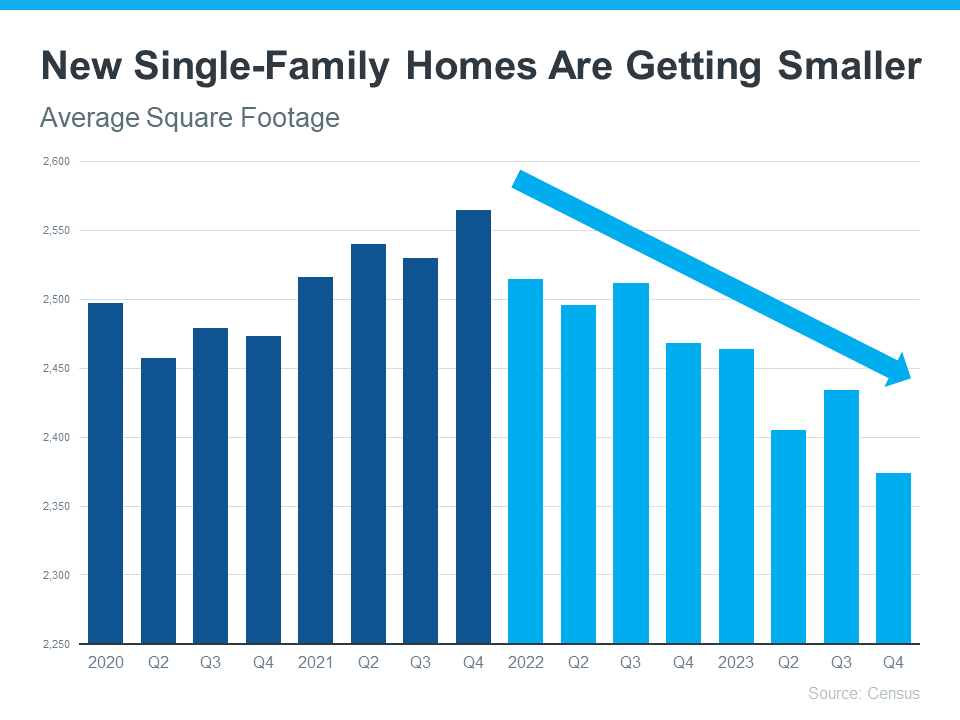Building Trend – Smaller Homes
Affordability remains a concern for many homebuyers. As market dynamics continue to shift, the quest for a home within budget often leads buyers to explore smaller housing options. Builders are now prioritizing the construction of smaller homes and sweetening the deal with enticing incentives, offering prospective buyers a wider array of choices that align with their financial goals.
Shifting Trends: The Rise of Smaller Homes
Throughout the pandemic, there was a surge in demand for larger homes, driven by the newfound need for spaces accommodating remote work, home gyms, and virtual schooling. Builders responded by focusing on constructing bigger residences to meet these evolving preferences.

Following the brief uptick in new home sizes in 2021, the average size of a new home continues to inch smaller — dropping from 2,479 square feet in 2022 to 2,411 square feet in 2023, the smallest average size in 13 years — to match home buyer preferences for less square footage. According to NAHB’s latest What Home Buyers Really Want study, home buyers are looking for homes around 2,070 square feet, compared to 2,260 20 years ago. Builders are acting on this trend, with 38% indicating they built smaller homes in 2023 to help support home sales and 26% indicating they plan to build even smaller in 2024.
What Do Smaller Homes Mean for Buyers?
For those struggling to find a home within their budget, exploring smaller housing options can be a viable solution. Moreover, opting for new builds may unlock additional perks such as price reductions or mortgage rate buy-downs, further enhancing affordability.
The boom in smaller construction has cut median new-home sizes by 4 percent in the past year, to 2,179 square feet, census data shows, the lowest reading since 2010. That’s helped bring down overall costs and contributed to a 6 percent dip in new-home prices in the same period.
Exploring smaller homes not only provides affordability but also offers the appeal of modern amenities and reduced maintenance requirements. For buyers seeking a balance between budget and comfort, these benefits make smaller homes a compelling choice.
Better, Not Bigger
Home buyers are not only shifting their preferences on size; they’re shifting their overall design preferences as well, placing higher value on personalization and authenticity.
Homeowners want their homes to feel like it was made just for them and be significantly different than their neighbors’ homes. This is reflected in the style of the home and the upgrades that buyers choose to incorporate into their homes, whether it’s creating an island that looks like a piece of furniture, higher quality cabinets or more expensive flooring. Home features that remain at the top of buyers’ wish list include:
- Laundry room
- Patio
- Energy Star window
- Exterior lighting
- Ceiling fan
- Garage storage
- Front porch
- Hardwood flooring
- Full bath on the main level
- Walk-in pantry
In Conclusion
The emergence of smaller homes in the market presents a silver lining for buyers navigating affordability challenges. By embracing this trend, prospective homeowners can access a wider range of options that align with their financial circumstances. If you’re considering a home purchase, now is the time to explore the diverse array of smaller homes available and seize the opportunity for affordable homeownership. Let’s connect to explore the possibilities within our area and find the perfect fit for your needs and budget.

